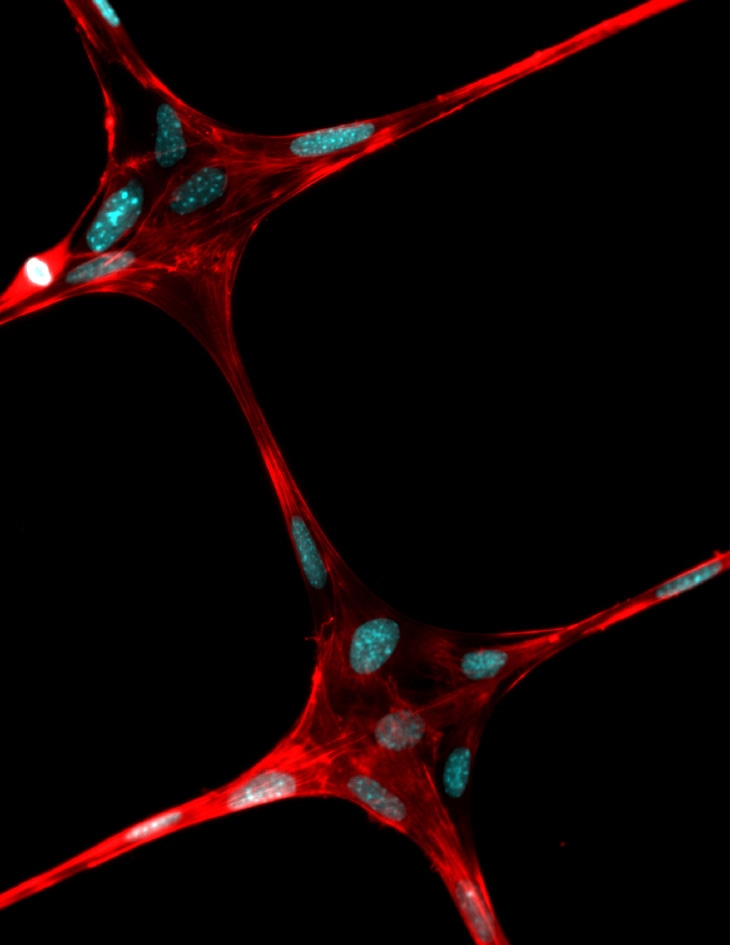Dec 13 2017
While a frame is capable of providing structural support for a house and the chassis has the potential to provide shape and strength for a car, a team of Penn State engineers are certain that they have a way for creating the structural framework for growing living tissue with the help of an off-the-shelf 3D printer.
 This figure displays the cells grown on polymeric fibers created by 3-D near field electrospinning. Image: Justin Brown / Penn State
This figure displays the cells grown on polymeric fibers created by 3-D near field electrospinning. Image: Justin Brown / Penn State
We are trying to make stem-cell-loaded hydrogels reinforced with fibers like the rebar in cement. If we can lend some structure to the gel, we can grow living cells in defined patterns and eventually the fibers will dissolve and go away.
Justin L. Brown, Associate professor of Biomedical Engineering
In a latest issue of the Journal of Advanced Healthcare Materials, the researchers report that their goal is to develop a novel, efficient and low-cost method for fabricating repeatable and high-resolution 3D polymer fiber patterns on non-conductive materials for tissue engineering with available hobbyist-grade 3D printers. The method they employ is a combination of electrospinning and 3D printing, a method using electric charge in order to spin nanometer threads from either a solution or polymer melt.
Presently, almost all complex transplant tissues, from kidneys and hearts to tendons, come from dead or living donors. The researchers are looking for a way to grow replacement tissues in a reliable manner by using economical methods. The combination of electrospinning and 3D printing to produce a scaffold for tissue engineering could also allow production of combined tendons and muscles, or cartilage and tendons, for example.
The overarching idea is that if we could multiplex electrospinning with a collagen gel and bioprinting, we could build large and complex tissue interfaces, such as bone to cartilage. Others have created these combination tissues using a microextrusion bioprinter.
Pouria Fattahi, Doctoral Student in Bioengineering
These present strategies produce the different tissues separately and then combine them using some type of connector or adhesive. However, in the body, tissues such as bone and cartilage, and muscles and tendons, grow seamlessly together.
The researchers' apparatus employs the electrospinner in order to replace the extruder nozzle on the 3D printer. The printer is capable of depositing an exact pattern of fibers in three dimensions to produce a scaffold in a hydrogel on which cells can grow. After the tissue reaches sufficient growth, it will be possible to dissolve the scaffolding, leaving just a structured tissue appropriate for use.
If two varied tissues —tendon and muscle — are required, the 3D printer will be able to alter the pattern of threads in such a manner that the transition could be continuous with the suitable cells, leading to a naturally formed, two-part tissue replacement.
The researchers are presently working on tissues that are a little less than 1 inch cubes, however, even this might have some utility.
The anterior cruciate ligament, or ACL, is only about 2 to 3 centimeters (.8 to 1 inch) long and 1 centimeter (.8 inches) wide.
Pouria Fattahi
The researchers used near-field electrospinning to first produce remarkably thin threads in the nanometer and micron range. This was followed by demonstrating that they could grow cells on these fibers, and finally depositing patterned fibers into a collagen gel loaded with cells.
Jordan T. Dover, undergraduate student in biomedical engineering was also part of this project.
This work was supported by the National Institutes of Health.